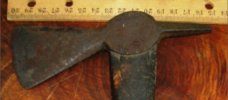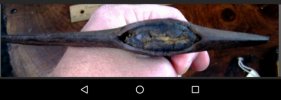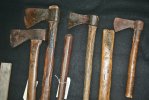Here is some more unexperienced foolishness to brush aside.
Strange that a "trappers axe" that is intended to split firewood and clear trees from trails doesn't look more like a boy's axe at the minimum. A 2 1/2 pound head on a 28" handle would be better suited and might even be considered a minimum for that kind of work if performed with any frequency.
Looking through outfitters catalogs and magazine articles from the early 1900s we don't see the term "trappers axe" used to describe anything larger than a Hudson Bay axe and in many cases it is much smaller. Abercrombie and Fitch lists their "New Trappers Axe" in the 1916 catalog. It sports a 16" handle and weighs 2 pounds. browsing through old publications like Outing, Field and Stream, Hunter Trader Trapper we occasionally see reference to "trappers axes" and "camp axes". They all fit in a range of something like a 16" handle 1 1/2 pound head to the Hudson bay at up to 2 pounds and a 27" handle. Bigger than a belt or Scout hatchet but smaller than a Boys' axe. Boy those trappers must have loved to work. Clearing and bucking all those trees by day and splitting firewood all night with those little long handles hatchets, its a wonder they had time to tend traps and put up fur...
Makes you wonder maybe why they would not have had a full size axe or at least a 3/4 axe at the cabin for splitting firewood and clearing trees. I guess they didn't need to if the little trappers axe was designed for these things.
The logical conclusion or perhaps "foolishness" is that "The trappers axe", The Hudson Bay included in the upper end of that spectrum, must have been used for some other things. Maybe not splitting or chopping/clearing but some other things specific to the trapline that a small axe was good at but a bigger axe wasn't needed for...
Would an occasional tree need to be cleared or some kindling split? Certainly but I would consider those as outlier tasks compared to many other trapline tasks. Clearing large numbers of deadfalls is pre season work, not mid season work to be done while trapping but I suppose people do as they see fit. Trapping by itself is time consuming enough to make you want to do as much as possible of the maintenance type stuff well before you start trapping.
Some of those specific on the line tasks are cutting poles and stakes for trap sets, hammering nails and stakes, breaking ice, an extension of the hand to help in climbing a bank, hooking trap chains, chopping feet and tails, dispatching caught animals, chopping meat baits and cutting and peeling bark from beaver bait sticks, possibly helping to save you if you fall through ice, cutting a pole to assist in feeling the bottom for beaver runs or pulling up a submerged trap, constructing under ice beaver sets or flattening a log to position a trap at a stream crossing, blazing a trail or marking set locations, rough carving a replacement canoe paddle, chopping a hole in a beaver dam, chopping a root that is in the way, etc...all this and more and it needs to ride well in a pack basket without getting in the way or sticking out too much.
These are the tasks that define and shaped what a trappers axe is... Something bigger than a hatchet, something smaller than a Boy's axe. Historic literature and trapline use have shaped my opinion on that. I respect that there may be other opinions as well. I don't get bent out of shape about that, nor do I make assumptions about the experience of people I know nothing about.
Strange that a "trappers axe" that is intended to split firewood and clear trees from trails doesn't look more like a boy's axe at the minimum. A 2 1/2 pound head on a 28" handle would be better suited and might even be considered a minimum for that kind of work if performed with any frequency.
Looking through outfitters catalogs and magazine articles from the early 1900s we don't see the term "trappers axe" used to describe anything larger than a Hudson Bay axe and in many cases it is much smaller. Abercrombie and Fitch lists their "New Trappers Axe" in the 1916 catalog. It sports a 16" handle and weighs 2 pounds. browsing through old publications like Outing, Field and Stream, Hunter Trader Trapper we occasionally see reference to "trappers axes" and "camp axes". They all fit in a range of something like a 16" handle 1 1/2 pound head to the Hudson bay at up to 2 pounds and a 27" handle. Bigger than a belt or Scout hatchet but smaller than a Boys' axe. Boy those trappers must have loved to work. Clearing and bucking all those trees by day and splitting firewood all night with those little long handles hatchets, its a wonder they had time to tend traps and put up fur...
Makes you wonder maybe why they would not have had a full size axe or at least a 3/4 axe at the cabin for splitting firewood and clearing trees. I guess they didn't need to if the little trappers axe was designed for these things.
The logical conclusion or perhaps "foolishness" is that "The trappers axe", The Hudson Bay included in the upper end of that spectrum, must have been used for some other things. Maybe not splitting or chopping/clearing but some other things specific to the trapline that a small axe was good at but a bigger axe wasn't needed for...
Would an occasional tree need to be cleared or some kindling split? Certainly but I would consider those as outlier tasks compared to many other trapline tasks. Clearing large numbers of deadfalls is pre season work, not mid season work to be done while trapping but I suppose people do as they see fit. Trapping by itself is time consuming enough to make you want to do as much as possible of the maintenance type stuff well before you start trapping.
Some of those specific on the line tasks are cutting poles and stakes for trap sets, hammering nails and stakes, breaking ice, an extension of the hand to help in climbing a bank, hooking trap chains, chopping feet and tails, dispatching caught animals, chopping meat baits and cutting and peeling bark from beaver bait sticks, possibly helping to save you if you fall through ice, cutting a pole to assist in feeling the bottom for beaver runs or pulling up a submerged trap, constructing under ice beaver sets or flattening a log to position a trap at a stream crossing, blazing a trail or marking set locations, rough carving a replacement canoe paddle, chopping a hole in a beaver dam, chopping a root that is in the way, etc...all this and more and it needs to ride well in a pack basket without getting in the way or sticking out too much.
These are the tasks that define and shaped what a trappers axe is... Something bigger than a hatchet, something smaller than a Boy's axe. Historic literature and trapline use have shaped my opinion on that. I respect that there may be other opinions as well. I don't get bent out of shape about that, nor do I make assumptions about the experience of people I know nothing about.
Last edited:












